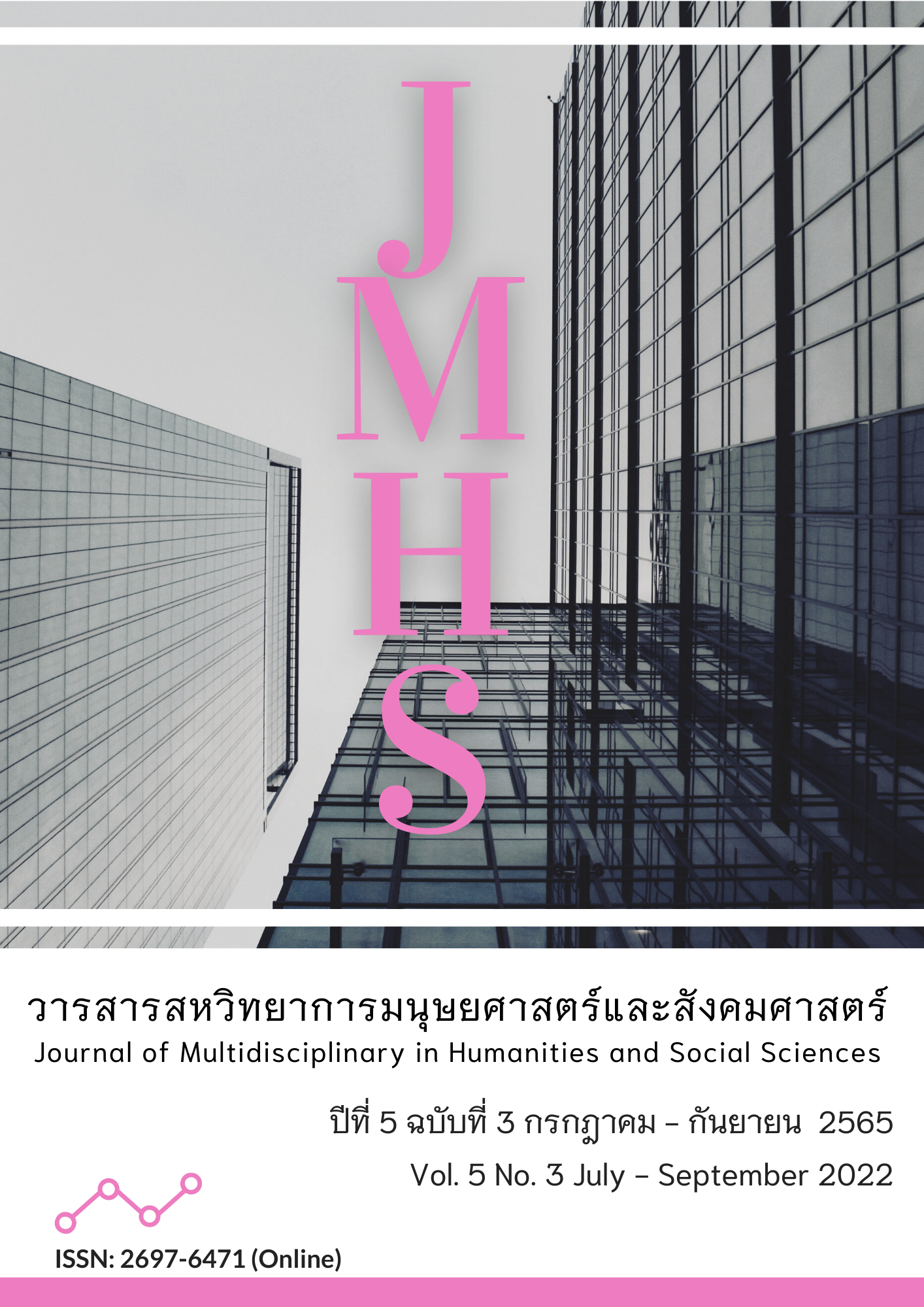The Causal Factors Affecting the Behavior of Using Social Media in Communication Within the Organization of Personnel of the Energy Regulatory
Main Article Content
Abstract
Technology is the most important tool for communication and creates awareness, adaptation, and transformation of received messages. Hence, communication is essential for living and working. The objectives of this research article were 1) to develop and validate the consistency of a causal relationship model for the behavior of using social media in communication within the organization of personal energy regulations and 2) to study causal factors affecting the behavior of using social media in communication within the organization of personal energy regulations. The sample group consisted of 248 people who used social media for communication. The tools used in the research were online questionnaires. The statistics used in data analysis were frequency, percentage, and the structural equation model.
The results of this research showed that the causal relationship model of variables consisting of 5 components consisted of: 1) attitude, 2) subjective norm, 3) perceived behavioral control, 4) behavioral intention, and 5) usage behavior and the model developed in accordance with empirical data to a great extent. The statistics showed the chi-square statistics goodness fit test (χ2) = 167.45, degrees of freedom (df) = 149, CMIN/df = 1.12, GFI = 0.94, AGFI = 0.90, SRMR = 0.02, RMSEA = 0.05. The final result was a predictive coefficient of 0.99, indicating that the variables in the model could explain the behavior of using social media in communication personal energy regulations by 99 percent and behavioral intention, attitude, and perceived behavioral control influence the behavior of using social media in communication within the organization of personnel energy regulations.
Article Details

This work is licensed under a Creative Commons Attribution-NonCommercial-NoDerivatives 4.0 International License.
Views and opinions appearing in the Journal it is the responsibility of the author of the article, and does not constitute the view and responsibility of the editorial team.
References
กริช แรงสูงเนิน. (2554). การวิเคราะห์ปัจจัยด้วย SPSS และ AMOS เพื่อการวิจัย. กรุงเทพฯ: ซีเอ็ดยูเคชั่น.
กู้เกียรติ ก้อนแก้ว และวิภาดา ศรีเจริญ. (2563). ปัจจัยเชิงสาเหตุที่มีอิทธิพลต่อพฤติกรรมการใช้หมวกนิรภัยในนักศึกษาสาขาสาธารณสุขศาสตร์ มหาวิทยาลัยราชภัฏพิบูลสงคราม จังหวัดพิษณุโลก. วารสารวิทยาศาสตร์และเทคโนโลยี. มหาวิทยาลัยมหาสารคาม, 39(3), 323-330.
นงลักษณ์ วิรัชชัย. (2542). โมเดลลิสเรล: สถิติวิเคราะห์สำหรับการวิจัย (พิมพ์ครั้งที่ 3). กรุงเทพฯ: โรงพิมพ์แห่งจุฬาลงกรณ์มหาวิทยาลัย.
นภสินธุ์ สุวรรณธาร และ บดินทร์ รัศมีเทศ. (2564). ปัจจัยที่ส่งผลต่อการตัดสินใจเลือกซื้อกองทุนออนไลน์ผ่านแอปพลิเคชันในเขตกรุงเทพมหานคร. วารสารศิลปการจัดการ, 5(3), 586-598.
นันทพร เขียนดวงจันทร์ และ ขวัญกมล ดอนขวา. (2558). พฤติกรรมผู้บริโภคในการซื้อสินค้าผ่านสื่อสังคมออนไลน์ของคนในกลุ่มเจเนเรชันวาย. Veridian E-Journal, Silpakorn University, 11(1), 561-577.
นันทพร เขียนดวงจันทร์ และ ขวัญกมล ดอนขวา. (2562). ทัศนคติ และความตั้งใจที่มีอิทธิพลต่อพฤติกรรมผู้บริโภคในการซื้อสินค้าผ่านไลน์. วารสารเทคโนโลยีสุรนารี, 13(2), 58-78.
นิธินาถ วงศ์สวัสดิ์ และ ปวีณา คำพุกกะ. (2557). ความตั้งใจของผู้ซื้อขายหลักทรัพย์ผ่านอินเทอร์เน็ต. วารสารสมาคมนักวิจัย, 19(2), 56-67.
นิษา ศักดิ์ชูวงษ์. (2565). ปัจจัยเชิงสาเหตุที่มีอิทธิพลต่อความตั้งใจเชิงพฤติกรรมในการใช้งานแอปพลิเคชันถุงเงินของผู้ประกอบการในจังหวัดอุดรธานี. วารสารสังคมศาสตร์และมานุษยวิทยาเชิงพุทธ, 7(2), 294-309.
ณฐวัฒน์ พระงาม. (2555). การติดต่อสื่อสารแบบปฏิสัมพันธ์ในองค์การ. พิษณุโลก: มหาวิทยาลัยพิษณุโลก.
ประเสริฐ ศีลพิพัฒน์. (2563).การบริหารจัดการทรัพยากรโทรคมนาคม.วารสารวิชาการ กสทช., 4(4), 45-55.
รัฐธินี สุทธิผลไพบูลย์ และ สมชาย เล็กเจริญ. (2563). ปัจจัยเชิงสาเหตุที่มีผลต่อพฤติกรรมการใช้งานเว็บไซต์ RTAF.LIVE ในการรับข้อมูลข่าวสารของข้าราชการกองทัพอากาศไทย. วารสารรังสิตสารสนเทศ, 27(2), 6-25.
ศุภสัณห์ เกิดสวัสดิ์ และ สุมามาลย์ ปานคำ. (2563). รูปแบบความสัมพันธ์เชิงสาเหตุของทฤษฎีรวมการยอมรับและการใช้เทคโนโลยีที่มีผลต่อพฤติกรรมการสื่อสารภายในองค์กรผ่านโซเชียลมีเดียของข้าราชการโรงเรียนเตรียมทหาร สถาบันวิชาการป้องกันประเทศ. วารสารศรีนครินทรวิโรฒวิจัยและพัฒนา, 12(24), 103-112.
สมคิด บางโม. (2558). องค์การและการจัดการ. (พิมพ์ครั้งที่ 7). กรุงเทพฯ: วิทยพัฒน์.
สำนักงานคณะกรรมการกำกับกิจการพลังงาน. (2564). แผนการดำเนินงานงบประมาณรายจ่ายและประมาณการรายได้ ประจำปี 2565. สืบค้นเมื่อ 5 มีนาคม 2565, จากhttps://www.erc.or.th/ERCWeb2/Upload/Document.pdf
อินทิรา ไชยณรงค์. (2561). ทฤษฎีพฤติกรรมตามแผนกับความตั้งใจออกกำลังกายด้วยการเดินในผู้ป่วยภายหลังเกิดโรคหลอดเลือดสมอง. วารสารพยาบาลทหารบก, 19(1), 47-55.
Ajzen, I., & Fishbein, M. (1980). Understanding Attitudes and Predicting Social Behavior. New Jersey: Prentice Hall.
Chen, H. R., & Tseng, H. F. (2012). Factors That Influence Acceptance of Web-Based E-Learning Systems for the in-Service Education of Junior High School Teachers in Taiwan. Evaluation and Program Planning, 35(3), 398-406.
Davis, F. D. (1989). Perceived Usefulness, Perceived Ease of Use, and User Acceptance of Information Technology. MIS quarterly, 319-340.
Fishbein, M., & Ajzen, I. (2010). Predicting And Changing Behavior: The Reasoned Action Approach. New York: Psychology Press.
Gopi, M., & Ramayah, T. (2007). Applicability of Theory of Planned Behavior in Predicting Intention to Trade Online: Some Evidence from A Developing Country. International Journal of Emerging Markets, 2(4), 348-360.
Hair, J. F., Black, W. C., Babin, B. J., & Anderson, R. E. (2010). Multivariate Data Analysis. (7th ed.). New York: Pearson.
Hoelter, J. W. (1983). The Analysis of Covariance Structures: Goodness-of-Fit Indices. Sociological Methods & Research, 11(3), 325-344.
Kline, R. B. (2011). Convergence of Structural Equation Modeling and Multilevel Modeling. https://dx.doi.org/10.4135/9781446268261.n31
Munn, D. P. (1971). A study of sources for Swinburnes's Lesbia Brandon. (Doctoral dissertation). Texas Tech University.
Pong, L.T., & Yee, T.P. (2001). An Integrated Model of Service Loyalty. Retrieved October 20, 2021, from http://www.sba.muohio.edu/abas/2001/brussels.


